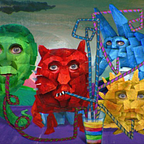The central theme of this book seems to me to be that age old struggle. No, not ‘good’ versus ‘evil’; More, the blossoming of the creative impulse versus the relentless onslaught of blind process.
The creative spark finds it’s well-spring in the other world; It needs to be nurtured and channeled through, into our world. All the while, there is the pressing danger that unyielding ‘process’ will sweep it away.
Logical steps, blindly repeating the rule; An all-consuming machine.
‘Johnnie Walker’ is one of the more enigmatic characters in this novel; As with ‘Colonel Sanders’, the other deeply ingrained product logo, they seem to be devices used to denote a ‘concept made visible’.
Colonel Sanders reinforces several times to Hoshino that he is neither a god, nor a buddha, he is a ‘metaphysical conceptual object.’
Johnnie Walker appears to be the embodiment of that most ruthless force; Namely the automated, unflinching and unrelenting ‘process’; A process that, once entrenched, can consume all. It leads to its own ‘logical’ conclusion, which often turns out to be the exact opposite of the impulse that started it.
Johnnie Walker discusses with Nakata this impersonal drive. He is not doing something he wants to do or deriving any pleasure from it.
In his interaction with Nakata, he emphasises several times ‘doing things in the right order’ going through the correct steps and then repeating. He admonishes Nakata that he has to look. That is a rule. ‘Closing your eyes isnt going to change anything. Nothing’s going to disappear just because you cant see whats going on.’
Like any process, it gains a momentum all of its own. It is self fuelling. The making of ‘cat flutes’ must necessarily lead on to the making of ‘human flutes!’
This idea is echoed when Kafka reads about Adolf Eichmann in the cabin. The Nazi war criminal who designed the final solution for the Jews. Kafka reads that, at his trial, Eichmann couldnt work out why he was there. He was just a technician who’d found the most efficient solution to the problem assigned to him!
In the back of the Eichmann book Kafka reads a pencilled note written by Oshima:
“It’s all a question of imagination. Our responsibility begins with the power to imagine. It’s just as Yeats said: In dreams begin responsibility. Turn this on its head and you could say that where there’s no power to imagine, no responsibility can arise. Just as we see with Eichmann.”
There is a further echo of this idea with the two visitors Oshima has to deal with in the library. ‘Hollow people’ with no imagination. Dangerous people because they will follow things to a logical conclusion wherever that leads, without a safety valve or regulator.
The use of the Johnnie Walker logo is interesting, considering the brands advertising motto, ‘keep walking’.
The two times we actually see him in the novel, he is perfectly static; In an entrenched position. Johnnie Walker does not walk.
When he meets Nakata, he requires an intermediary to bring him to him. He remains seated and is seated again when the boy called crow discovers him in a clearing. The text describes him as wearing thick soled walking boots, but these seem to be just for show. He tells the boy, ‘i’m thinking of taking all the flutes i’ve made and creating a much larger, far more powerful flute out of them — a super size flute that becomes a system unto itself.’ Further he states, ‘ I am a man entirely without prejudices, like history or the weather — unbiased. And since I am, I can transform into a kind of system.’
Toro the black cat reveals to Hoshino a further clue. He tells him he needs to kill something that wishes to reach the entrance stone. This something doesn't have any real form, it changes shape depending on the situation.
Toro further explains that ‘its probably not all that dangerous when its on the move’, ‘Once it stops moving though, watch out. That’s when its dangerous!’
The creature that emerges from Nagata seems to be the vulnerable mobile form of ‘Johnnie Walker’. A form ironically, without legs!
Like much of Murakami’s work, the ‘other world’ figures heavily.
The other world is the creative well-spring that ‘feeds’ our more regulated world. Like the Grail Castle or the world of Faerie, this world is not readily accessible, but ways can open up, but then, just as easily close again!
Anything truly creative derives from that world. The two chords in Miss Saeki’s song that so affected Kafka, were found in that world, as two lizards in a far-off, distant room.
Ideas, emotions and concepts have form and autonomy in that ‘other world;
That is where Kafka must travel to end the process.
His outer journey mirrors his inner journey and vice versa. A descent into the labyrinth to confront the ‘monster’.
You sit at the edge of the world, I am in a crater that is no more.
Words without letters, Standing in the shadow of the door.
The moon shines down on a sleeping lizard, Little fish rain down from the sky.
Outside the window there are soldiers, steeling themselves to die.
Kafka sits in a chair by the shore, Thinking of the pendulum that moves the world.
It seems; When your heart is closed,
The shadow of the unmoving Sphinx becomes a knife that pierces your dreams.
The drowning girl’s fingers. Search for the entrance stone, and more.
Lifting the hem of her azure dress,
She gazes — — at Kafka on the shore.
It is, of course, Oedipus’ destiny to solve the riddle of the ‘unmoving’ sphinx.
